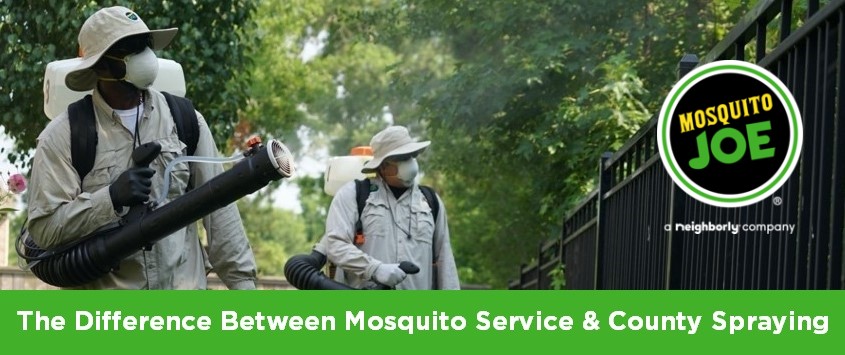What’s the Difference Between Mosquito Service and County Spraying?

We often get customers calling us to let us know that we don’t need to treat their yard because the county sprayed. We also have people ask us why they would need our barrier service if the county sprays the streets. We thought clearing up the differences would be helpful.
County Spraying:
Typically, you will see counties getting out and spraying the streets when West Nile or another disease has been found at mosquito testing sites. Understanding the purpose of street spraying and appreciating mosquito behavior will help explain the differences between what the county does and what we do.
Mosquitoes spend a good majority of their time feeding on plant nectar, typically on the underside of leaves so they can shelter from the sun. They don’t fly well and typically “shrub hop” as they move about. They are very sun phobic, and you will see them out typically at dawn and dusk. They require water to hatch their eggs, so will lay them in stagnant bodies or on damp soil.
The intent in street spraying is to reduce the population’s numbers which is why they typically spray in the early morning or later in the evening. Mosquitoes don’t tend to fly around over asphalt, but the females do take advantage of standing water in ditches to lay eggs. While no one yet knows how to kill the eggs, the best way to reduce the population as a street truck is to treat the streets with a focus on those ditches.
Aerial Spraying:
Aerial spraying is less common in our area, but several years ago it was done when West Nile levels rose beyond what we typically see. Since a plane can cover large areas and is not limited to the streets, it allows the county to make more of an impact on the population. As the mist falls it settles on the leaves and grass, killing mosquitoes it touches along the way. Again, the purpose is to reduce the overall population. Since mosquitoes are typically on the underside of leaves a substantial portion of the population will be unaffected, but the overall population will be reduced.
Mosquito Joe Barrier Service:
The intention of our service is not to reduce the population, but to get our customers to a 95% reduction. We do this in several ways: We remove all the standing water in your yard that we can, and we treat any that we can’t prevent mosquito larvae from hatching into adult mosquitoes. This includes saucers under plant pots, checking your gutters, treating French drains, and more. We use garlic around flowering plants, fruit trees, and vegetable gardens. The garlic pushes mosquitoes elsewhere in the yard, so we can kill them while avoiding the beneficial insects in your yard, such as bees and butterflies. Finally, we treat all the green leaf in your yard by coating both the top and the underside of the leaves. The products we use adhere to the leaf and once dry will not wash off or rub away. As a mosquito hops into your yard and onto a leaf, it will die. Our products continue working for 3 weeks, at which point they will have completely broken down. The majority of our customers are on a three-week cycle to maintain their 95% reduction.
As you can see, Mosquito Joe tailors a mosquito service to your yard and hits all the potential areas where they live, breed, and multiply. Our focus is on making your outside fun again rather than reducing an overall population.


